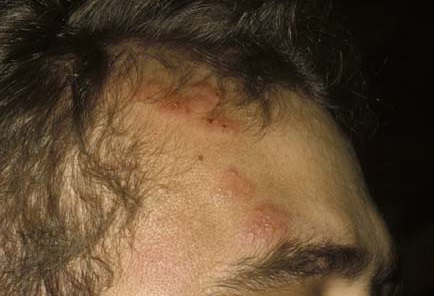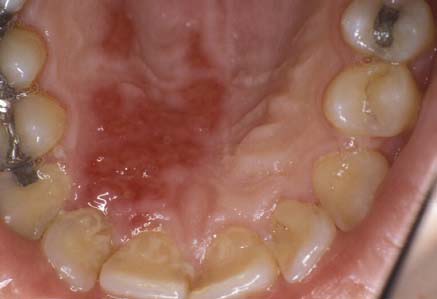Varicella‐Zoster Disease (Shingles)
The varicella-zoster virus (VZV) is a member of the human herpes virus family and is responsible for causing chicken pox and shingles.
|
Natural History of VZV infection The patient’s initial or primary VZV infection is called chicken pox and usually occurs during childhood. During healing, the patient’s immune system is only rarely able to totally eliminate VZV from the body. However, in most cases the immune system forces the virus into a dormant or latent state within the nerves. If the immune system becomes weakened in the future, VZV may be reactivated to cause the recurrent infection known as shingles. |
With the introduction of an effective vaccine, the risk of developing VZV disease has been greatly reduced for future generations. However, most living adults were exposed to VZV naturally and thus, are at risk for developing recurrence, a condition called shingles (see box to right). About 10% to 20% of patients harboring latent VZV will develop shingles and this risk increases with age.
Shingles
The characteristic lesion of shingles is a localized painful blister-type eruption that affects the skin or mucosa. The area affected is determined by its underlying sensory innervation. This unique feature means that the blisters or sores are most often confined to one side of the body and usually trace out a predictable pattern. Many patients experience pain or tingling for three to five days prior to developing the eruption. The small blisters quickly rupture to form crusts which typically heal within three weeks. Scarring is possible and in some cases the pain may last long after the eruption has healed. Any condition associated with a weakened immune system, such as advanced age or immunosuppressive drug therapy increases one’s risk of suffering from shingles. Below left is an example of shingles affecting the forehead of a patient and below right is an example of shingles affecting the roof of the mouth of a patient.


QUESTIONS AND ANSWERS ABOUT VARICELLA-ZOSTER DISEASE
Q: Am I at risk for developing shingles?
A: Anyone who has had chicken pox is at risk for developing shingles. As previously noted, if your immune system becomes weakened your risk of developing shingles goes up.
Q: Is shingles contagious?
A: Yes, VZV can be transmitted from one person to another via direct contact. If you have shingles you may also spread it from one area of your body to another area of your body, a process called autoinoculation. For example, if you touch a lesion and then inadvertently rub your eye, you may spread the virus to your eye. Thus, you should avoid contact with uninfected persons and wash your hands frequently with soap and water.
Q: How is shingles diagnosed?
A: The diagnosis is based on the patient’s history and clinical presentation. The rather characteristic appearance usually makes for a straightforward diagnosis, but special tests such as blood and immunologic studies may be necessary to confirm the diagnosis. If you suspect you have shingles, you should arrange to be seen by your healthcare provider as soon as possible.
Q: How is shingles treated?
A: Antiviral drugs effective against VZV are often prescribed to promote healing and reduce the risk of developing post-herpetic neuralgia (see next page). Agents which are commonly used include acyclovir (Zovirax), valacyclovir (Valtrex), and famciclovir (Famvir). Your doctor may also prescribe other medications such as ibuprofen or acetaminophen for pain control; a corticosteroid to help control inflammation; and a topical lotion such as diphenhydramine (Benadryl) to control itching. The effectiveness of drug therapy against shingles appears to be most successful when started within three day of blister formation.
Q: What is post-herpetic neuralgia?
A: Post-herpetic neuralgia is defined as pain that lasts for more than 30 days after the rash associated with shingles has healed. Your chances of getting post herpetic neuralgia increases with age (30% by age 40, >70% by age 70) and is also increased in the presence of a weakened immune system. The pain may resolve partially or completely over time or persist indefinitely.
Q: How is postherpetic neuralgia treated?
A: Treatment for postherpetic neuralgia is usually accomplished by a healthcare provider experienced in treating chronic neuropathic pain, such as a neurologist.
Q: Can shingles be prevented?
A: In 2006, the Food and Drug Administration licensed the vaccine Zostavax® to be used to prevent shingles in patients who are 60 years of age or older. You should check with your physician to determine if you should be vaccinated. For those who underwent vaccination against chicken pox, their risk of developing shingles appears to be lower than those who were exposed to chicken pox naturally.
Prepared by R. Balasubramaniam, E. Stoopler and the AAOM Web Writing Group
Updated 31 December, 2007
The information contained in this monograph is for educational purposes only. This information is not a substitute for professional medical advice, diagnosis, or treatment. If you have or suspect you may have a health concern, consult your professional health care provider. Reliance on any information provided in this monograph is solely at your own risk.